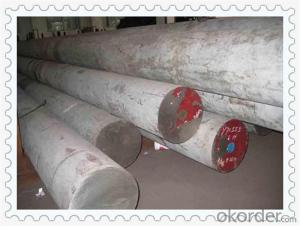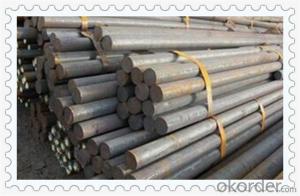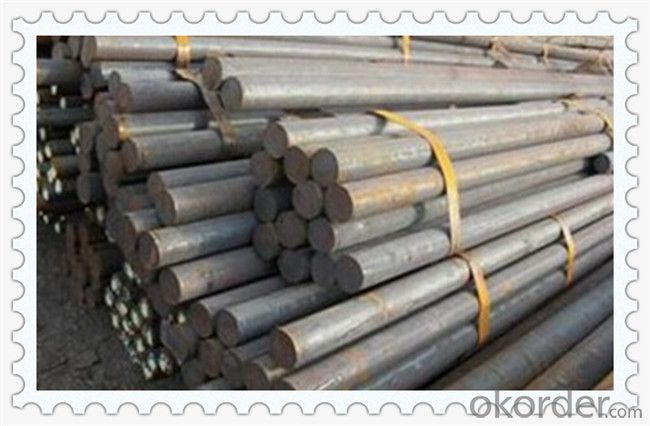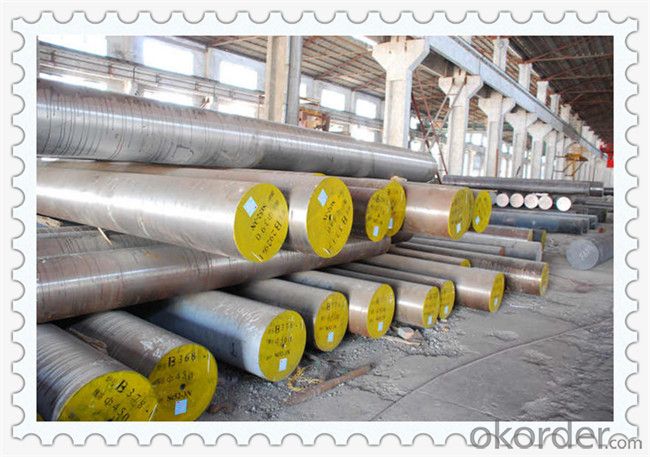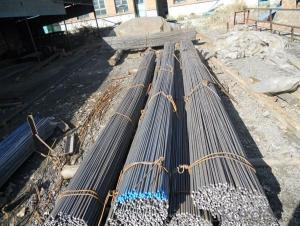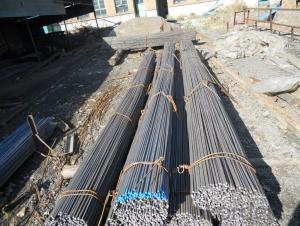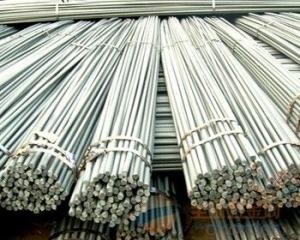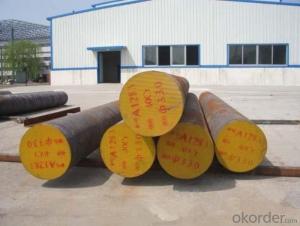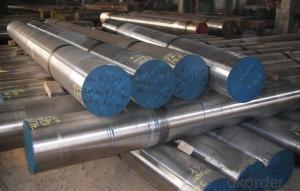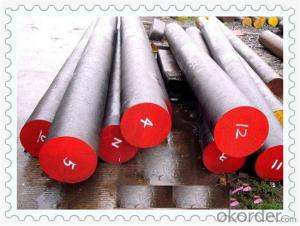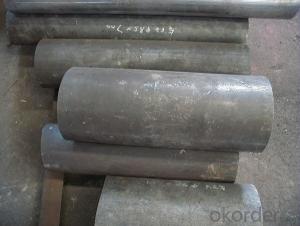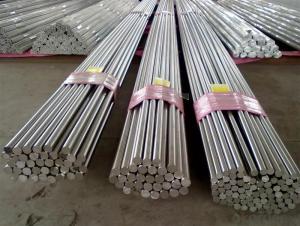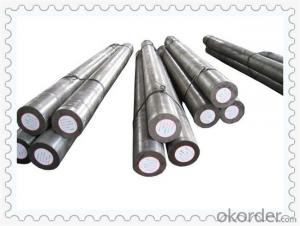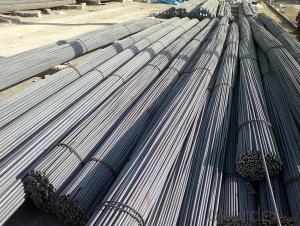SAE 1060 Carbon Steel Round Bars
- Loading Port:
- China main port
- Payment Terms:
- TT OR LC
- Min Order Qty:
- 30 m.t.
- Supply Capability:
- 10000 m.t./month
OKorder Service Pledge
OKorder Financial Service
You Might Also Like
SAE 1060 Carbon Steel Round Bars
Technical Paramenters
Chemical Composition | Mechanical Properties (In Quenched & Tempered State) | ||
C | 0.57-0.65 % | Tensile strength(MPA) | ≥675(69) |
Si | 0.17-0.37 % | Yield strength (MPA) | ≥400(41) |
Mn | 0.50-0.80 % | Elongation (δ5/%) | ≥12 |
Cr | ≤0.25 % | Reduction in Area (ψ/%) | ≥35 |
Ni | ≤0.25 % | Hardness | ≤255HB |
P | ≤0.035 % |
| |
S | ≤0.035 % |
| |
Cu | ≤0.25 % | ||
Products Show

Product Overviews
Description | Carbon Steel Rod/Carbon Steel Bar,carbon steel rod,carbon steel shaft,mild steel bar, Mild steel shaft,ms bar | |
Material | ASTM | 1005,1006,1008,1010,1015,1020,1025,1030,1035, 1040,1045,1050,1055,1060,1065,1070,1080,1084, 1016,1022 |
DIN | Ck10,Ck15,Ck22,Ck25,Ck30,Ck35,Ck40,Ck45,Ck50, 30Mn4,40Mn4 | |
BS | 040A04,095M15,045M10,080A40,045M10,080M50 | |
Standard | GB/T799,ASTM A29,A108,A321,A575,BS970,DIN1652,JIS G4051 | |
| Section shape | Round,square,hexagonal,flat,angle | |
| Surface | Black painted,galvanized | |
Specifications | Round bar | Diameter: 10mm~1200mm |
Angle bar | Size: 3mm*20mm*20mm~12mm*800mm*800mm | |
Square bar | Size: 4mm*4mm~100mm*100mm | |
Flat bar | Thickness: 2mm~100mm | |
Width:10mm~500mm | ||
| Hexagonal | Size: 4mm~800mm | |
Length | 2m,4m,5.8m,6m,11.8m,12m or as required. | |
Application
| Carbon Steel | Mold bottom, Plastic mold, Construction machinery parts Automobile parts, Security grills, Screens, Construction |
| Bearing Steel | Aerospace, Navigation, Nuclear energy, Chemical industry Electronic information, Petrochemical, Instrument and meter Transportation |
| Cr-Mo Steel | Mechanism & Fasteners gear, Stressed components for vehicles Engines and machines, Parts of larger cross-section |
| Gear Steel | All kinds of gears, Statically and dynamically stressed component for vehicles Engines and machine, Larger cross-section parts, Crankshafts |
Work Shop

Company Information
CNBM International Corporation is the most important trading platform of CNBM group.
Whith its advantages, CNBM International are mainly concentrate on Cement, Glass, Iron and Steel, Ceramics industries and devotes herself for supplying high qulity series of refractories as well as technical consultancies and logistics solutions.


FAQ
1, Your advantages?
professional products inquiry, products knowledge train (for agents), smooth goods delivery, excellent customer solution proposale
2, Test & Certificate?
SGS test is available, customer inspection before shipping is welcome, third party inspection is no problem
3, Factory or Trading Company?
CNBM is a trading company but we have so many protocol factories and CNBM works as a trading department of these factories. Also CNBM is the holding company of many factories.
4, Payment Terms?
30% TT as deposit and 70% before delivery.
Irrevocable L/C at sight.
5, Trading Terms?
EXW, FOB, CIF, FFR, CNF
6, After-sale Service?
CNBM provides the services and support you need for every step of our cooperation. We're the business partner you can trust.
For any problem, please kindly contact us at any your convenient time.
We'll reply you in our first priority within 24 hours.
Packaging & Delivery
1, Packaging: seaworthy package or as required
2, Delivery: 35-45 days or based on quantity

- Q: What are the advantages of using nickel-chromium-cobalt alloy steel round bars?
- There are several advantages of using nickel-chromium-cobalt alloy steel round bars. Firstly, this type of alloy steel has excellent corrosion resistance properties. It can withstand extreme environments, such as high temperatures, humidity, and exposure to chemicals, without succumbing to rust or corrosion. This makes it ideal for applications in industries like aerospace, marine, and chemical processing, where durability and longevity are crucial. Secondly, nickel-chromium-cobalt alloy steel round bars possess exceptional strength and toughness. They have a high tensile strength and can withstand heavy loads and impacts without deforming or breaking. This makes them suitable for applications that require structural integrity and resistance to deformation, such as in the construction industry or in manufacturing heavy machinery. Moreover, this alloy steel exhibits excellent heat resistance. It can withstand elevated temperatures without losing its mechanical properties, making it ideal for applications that involve high-temperature environments, such as in power generation, oil and gas exploration, or furnace components. Additionally, nickel-chromium-cobalt alloy steel round bars offer good wear resistance. They can withstand abrasive conditions, such as friction and wear, without experiencing significant deterioration. This makes them suitable for applications like tooling, machining, and wear components, where durability and resistance to wear are critical. Lastly, nickel-chromium-cobalt alloy steel round bars are highly versatile. They can be easily machined, welded, and formed into various shapes, making them adaptable to a wide range of applications. Their versatility allows for customization and flexibility in design and manufacturing processes. In conclusion, the advantages of using nickel-chromium-cobalt alloy steel round bars include excellent corrosion resistance, high strength and toughness, heat resistance, good wear resistance, and versatility. These qualities make them a preferred choice for various industries, where reliability, durability, and performance are essential.
- Q: What are the different mechanical properties of steel round bars?
- The different mechanical properties of steel round bars include tensile strength, yield strength, elongation, hardness, and impact resistance. Tensile strength refers to the maximum amount of stress a material can withstand before breaking. Yield strength is the stress at which a material begins to deform permanently. Elongation measures the amount of deformation a material can undergo before breaking. Hardness determines the material's resistance to indentation or scratching. Impact resistance is the ability of a material to absorb energy during sudden impacts without breaking.
- Q: How to determine the welding seam height of steel plate and steel bar?
- If the end of the vertical plane and the steel plate welding, welding angle as the bar diameter and the general welding height is 0.7 times the diameter of the arc can be reinforced; if the length direction of the surface of steel plate and steel welding, 2 side fillet weld cracks in the welded steel plate and steel between the full and round steel weldment the maximum diameter of arc phase can be flat.
- Q: How do you identify the grade of a steel round bar?
- The grade of a steel round bar can be identified through several methods. One way is to check the markings or labels on the bar itself. Manufacturers often stamp or engrave the grade directly onto the surface of the bar. These markings typically include information such as the grade designation (e.g., 304, 316, 4140), which represents the specific alloy composition, and may also include additional details such as the heat or lot number. Another method is to refer to the mill test certificate (MTC) that accompanies the steel round bar. The MTC provides comprehensive information about the composition, mechanical properties, and other relevant specifications of the material. The MTC is usually issued by the steel mill or supplier and can be requested upon purchase. Moreover, visual inspection and physical testing can help identify the grade of a steel round bar. Visual inspection involves observing the bar's appearance, texture, and color. Different grades of steel may exhibit distinct characteristics, such as a shiny or matte finish, specific surface treatments, or variations in color due to different alloying elements. Physical testing methods, such as tensile or hardness testing, can provide further confirmation of the steel grade. These tests measure the mechanical properties of the material, such as its strength, ductility, and hardness. By comparing the test results with known standards and specifications for different steel grades, one can determine the grade of the round bar. In summary, to identify the grade of a steel round bar, one can check for markings on the bar, refer to the mill test certificate, visually inspect the bar, and perform physical tests to assess its mechanical properties.
- Q: What are the advantages of using free-cutting steel round bars?
- Free-cutting steel round bars boast numerous advantages. Firstly, their impeccable machinability sets them apart. These bars are specifically designed for easy machining, allowing for smooth and efficient cutting, drilling, and shaping processes. This makes them highly suitable for applications that demand precision and intricate detailing, such as the production of automotive components, machinery parts, and precision instruments. Secondly, free-cutting steel round bars offer enhanced productivity and reduced manufacturing costs. Thanks to their superior machinability, these bars significantly reduce the time and effort required for machining, resulting in higher production rates and increased efficiency. Additionally, the reduced wear and tear on cutting tools lengthens their lifespan, thereby reducing tool replacement costs and overall manufacturing expenses. Moreover, free-cutting steel round bars excel in chip control. During machining, the chips produced can impact the final product's surface finish and dimensional accuracy. However, free-cutting steel round bars are specifically formulated to generate small, manageable chips that are easily expelled from the cutting zone. This not only enhances the quality of machined parts but also minimizes the risk of chip clogging or chip-related issues. Another advantage of utilizing free-cutting steel round bars lies in their superb surface finish. These bars are often manufactured with a fine grain structure and minimal impurities, resulting in a smooth and visually appealing surface finish. This becomes particularly crucial for applications where aesthetics and appearance play a significant role, such as in architectural designs or decorative purposes. Lastly, free-cutting steel round bars offer exceptional mechanical properties. They are typically produced with controlled chemical compositions and undergo precise heat treatments, ensuring consistent and reliable mechanical performance. This renders them suitable for demanding applications that necessitate high strength, toughness, and durability. In conclusion, the benefits of employing free-cutting steel round bars encompass exceptional machinability, improved productivity, reduced manufacturing costs, superior chip control, enhanced surface finish, and reliable mechanical properties. These advantages establish free-cutting steel round bars as the preferred choice in various industries and applications.
- Q: What are the advantages of using maraging steel round bars?
- Using maraging steel round bars in various applications offers several benefits. Firstly, these bars possess an impressive strength-to-weight ratio, making them ideal for situations where strength is crucial. They can withstand high stress and load-bearing conditions without deforming or failing, ensuring structural integrity. Secondly, maraging steel round bars exhibit exceptional toughness, enabling them to absorb significant amounts of energy before fracturing. This toughness makes them highly resistant to cracking or breaking, even under extreme conditions, enhancing their durability and reliability. Additionally, maraging steel round bars are known for their outstanding corrosion resistance. Unlike other types of steel, they are less prone to rust and oxidation, making them suitable for use in harsh environments or where exposure to moisture or chemicals is a concern. This corrosion resistance helps extend the lifespan of the bars and reduces maintenance costs. Furthermore, maraging steel round bars are relatively easy to machine, despite their high strength and hardness. They can be easily shaped, drilled, and cut into different forms and sizes, allowing for versatile applications across various industries. This ease of machining saves time and effort during the manufacturing process. Moreover, maraging steel round bars have excellent heat treatability, meaning they can be hardened and tempered to further enhance their mechanical properties. This flexibility in heat treatment allows for customization to meet specific project requirements, such as achieving desired hardness levels or improving characteristics like wear resistance or toughness. Lastly, maraging steel round bars are widely used in the aerospace and defense industries due to their exceptional strength, toughness, and corrosion resistance. They are commonly utilized in the manufacturing of critical components such as landing gear, missile casings, and aircraft structures, where reliability and performance are paramount. In conclusion, the advantages of using maraging steel round bars include high strength, superior toughness, corrosion resistance, machinability, heat treatability, and suitability for aerospace and defense applications. These properties make them the preferred choice for demanding industries, ensuring optimal performance and longevity in critical applications.
- Q: Can steel round bars be used in structural applications?
- Steel round bars are suitable for structural applications and commonly utilized in construction and engineering projects that prioritize strength and durability. They offer versatility and can function as beams, columns, and supports for various structural elements. Thanks to their exceptional mechanical properties, such as high tensile strength and good ductility, they can withstand heavy loads and resist deformation effectively. Moreover, their easy joinability to other structural components contributes to their popularity within the construction industry.
- Q: Are steel round bars available in different diameters?
- Yes, steel round bars are available in different diameters. Steel round bars come in a wide range of diameters, ranging from small sizes like 1/8 inch (3.175 mm) to larger diameters such as 12 inches (304.8 mm) or even more. These different diameters cater to various applications and industries, allowing for flexibility in choosing the appropriate size for specific projects or requirements.
- Q: Can steel round bars be used for making interior components?
- Yes, steel round bars can be used for making interior components. Steel is a durable and versatile material that can be shaped and formed into various designs and structures. Round bars are particularly suitable for creating interior components such as handrails, staircases, furniture frames, and decorative elements. They provide strength, stability, and an aesthetic appeal to interior spaces. Additionally, steel round bars can be easily welded, bent, or cut to meet specific design requirements, making them an ideal choice for custom-made interior components.
- Q: What is the maximum chromium content allowed for steel round bars?
- The allowable chromium content in steel round bars is determined by the grade or specification of the steel. Typically, the chromium content in these bars can span from 0.15% to 30%, although this range may vary depending on the desired properties and intended application of the steel. Stainless steel grades often exhibit higher chromium content as they are renowned for their resistance to corrosion. To ascertain the maximum allowable chromium content for particular steel round bars, it is crucial to refer to the pertinent industry standards or specifications.
Send your message to us
SAE 1060 Carbon Steel Round Bars
- Loading Port:
- China main port
- Payment Terms:
- TT OR LC
- Min Order Qty:
- 30 m.t.
- Supply Capability:
- 10000 m.t./month
OKorder Service Pledge
OKorder Financial Service
Similar products
Hot products
Hot Searches
Related keywords
